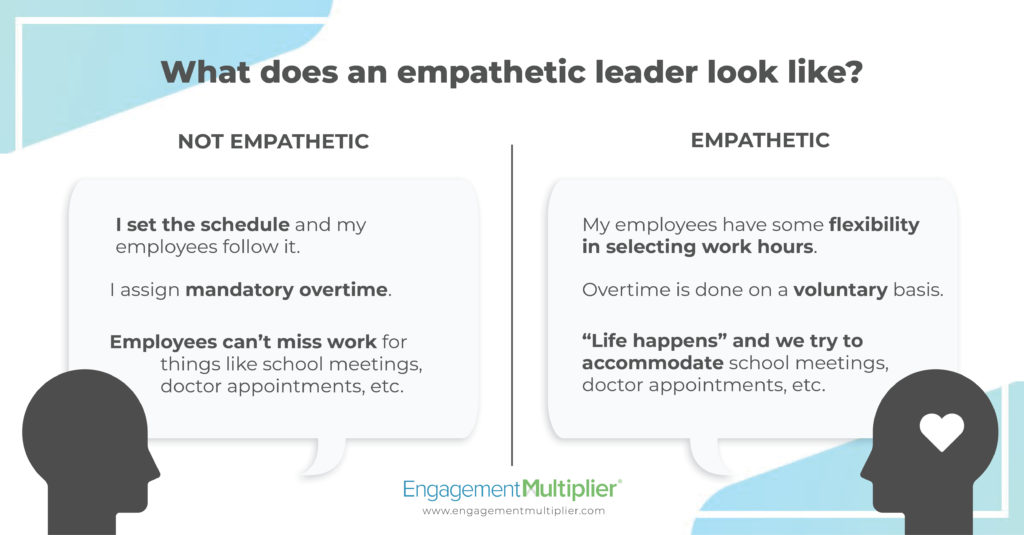“The future is going to require empathy at scale.”
This quote, from Bill McDermott, CEO of global workflow solutions giant ServiceNow, in a recent Forbes article on empathetic leadership, sums up the challenge facing so many leaders at this moment. So many employees are struggling, and leadership must develop an understanding of the challenges their people are facing.
But for those leading organisations of more than a couple dozen people, the concept of achieving any degree of empathy for all employees quickly becomes daunting.
- How can a leader really understand employees when they’re all working from home, much less practice empathy with each
- How can a leader create time to listen – and respond to what they hear – when they’re understaffed and running flat out?
- Is empathy at scale even possible, especially for a company head?
These are all good questions, given the definition of empathy, which according to the Cambridge dictionary, is “the ability to share someone else’s feelings or experiences by imagining what it would be like to be in that person’s situation.”
Empathy at scale only sounds daunting
For many leaders, the challenge “empathy at scale” poses is twofold: the idea of developing an understanding of employees’ feelings and experiences is out of their comfort zone, and even if it’s not, achieving the understanding necessary to be empathetic to all their employees seems impossible.
This is where it’s useful to step back and take a deep breath, because as you’ll soon see, “empathy at scale” is wholly possible.
First, understand and accept that while you, as a leader, can’t be all things to all people, and nor should you try, you can create conditions that support empathy for others throughout the organisation. Recognising that many employees are truly struggling is the first step. Preparing your leaders throughout the organisation to respond empathetically to their employees is the next.
Why empathetic leadership is important now
At the time of this writing, the “Great Resignation” is rolling on. In the US, more than 4.3 million people voluntarily resigned from their jobs in August – a figure that represents 3% of American workers – according to the US Labor Department’s Job Openings and Labor Turnover Survey.
Across the UK, Benelux, Germany, the Nordics, and the US, a recent survey from FirstUp found mounting employee dissatisfaction amongst the 23,000+ people surveyed. Two particularly telling findings from the survey suggest company leaders are either unaware or ignoring issues impacting their employees:
- Just 16% of employees said no changes were needed to improve their employee experience and help them feel more valued in work
- Only 12% of employees say their organisation has sufficient boundaries in place to ensure work/life balance.
As a result, people are leaving their jobs in droves, and leaders who overlook the importance of ensuring people feel valued, as well as taking steps to reduce burnout by prioritising employees’ work/life balance are more likely to suffer increased employee than those who ensure employees feel valued and take steps to keep their team energised.
This is where empathy becomes critical. Look again at those stats. The significant majority of employees surveyed say that changes are needed to ensure they feel valued and that their work isn’t overwhelming their personal lives – over 80% in both cases.
These statistics illustrate some of the underlying reasons why so many people are re-evaluating their lives and work, and are subsequently deciding to change.
Empathetic leaders recognise that the pandemic has had an undeniable impact on people, and because they’re paying attention to their employees, they are in tune with the changing expectations and needs of their people.
An empathetic leader will ask people how they’re doing and will strive to understand what their people are thinking and feeling. As a result, they will know if their team understands how their work contributes to the organisation’s success, or whether employee workloads are sustainable. Importantly, they will not assume that people are motivated solely by money, nor believe they are willing to simply carry on for the sake of getting paid.
How to achieve “empathy at scale”
Empathy at scale means understanding broadly the sentiment within your organisation, so, as a leader, you’re operating from a position of truth, and can make better decisions. As your organisation grows larger, it becomes increasingly difficult (and eventually impossible) to keep tabs upon individual employees. However, that doesn’t mean that leaders of larger organisations can abandon empathy.
Here’s how to achieve empathetic leadership at scale.
Set your assumptions aside. It’s difficult for people to put themselves in others’ shoes, especially when individual circumstances and challenges are so varied. However, in moments like this one, clinging to one’s assumptions can be truly detrimental. A multiplicity of studies this year have revealed the extent to which executives are often wrong about matters relating to their employees. The safest assumption you can make about your employees is that you have no idea of where they stand.
Depending upon the size of your organisation, it may be useful to take a page from the playbook written by professional change consultants and create personas of various employee groups, as highlighted in this article on the role of empathy in organisational change from Harvard Business Review. Thinking in terms of the various groups of employees within your organisation can help leaders guard against making blanket generalisations. However, as the same change managers will tell you, people’s wants and needs will evolve, and leaders should update employee personas as new data is gathered.
Ask them. Now that you have an open mind and a clean slate, the next step is straightforward: ask people what they’re thinking and how they’re feeling. However, it’s equally important to create a safe, anonymous space in which they can respond, and thus provide you with accuracy and truth. Noncommittal answers will not provide leaders with the perspective they need to respond empathetically to their people.
The aforementioned HBR article on empathy and organisational change included a discussion of how one successful organisation gathered information from employees to enable empathetic leadership as the organisation navigated a significant change:
“We interviewed individual employees in each segment to get a sample perspective on typical mindsets. During the interviews, we asked questions designed to uncover beliefs, feelings, questions, and concerns about the company’s current strategy. We also asked if there were specific changes they hoped management would (or would not) make.
Using the insights from these interviews, we were able to identify how each employee segment felt about the change effort, and planned communications based on whether they were excited, frightened, or frustrated.”
Allow technology to assist you. The interview process described above probably sounds pretty good – and also, pretty time-consuming. Anonymous surveys that guarantee that employees’ answers will remain confidential and protect individuals’ anonymity can enable leaders to swiftly gather the answers they need. Partners like Engagement Multiplier will provide expertly designed surveys that give leaders broad perspective, and aren’t just a simple gauge of sentiment, and should allow the survey data to be sliced and diced across groups, departments, locations, roles, hire dates – whatever criteria best suit the organisation. Survey reports should provide you with an at-a-glance understanding of where challenges exist within your organisation, as well as what’s causing them.
As we mentioned earlier, leaders can’t be all things to all people, and there will be exceptions that pop out as you review survey data. However, patterns in the data will be equally evident to you – and those are truly invaluable. From those, you’ll be able to understand whether employees feel truly connected to the organisation and its purpose, or whether those connections are growing weak. You’ll be able to ascertain whether employees are feeling proud of their work, have strong relationships with each other, are confident in their leaders, and if they feel valued.
The data patterns – informed by the free-form input from employees that a good survey should also invite – will enable you to understand what’s working well within the organisation, and enable you to prioritise your next steps to either rectify misunderstanding, allay fears, or take action to improve the business.
Share the findings. Once you’ve reviewed your survey results and have identified the key findings and priorities you plan on addressing, it’s time to share the results – first with leaders, and then more broadly with employees.
When sharing the findings with leaders, it’s worthwhile to also discuss the response. In our long experience, employees most often simply want more communication from leaders and a better understanding of the company’s strategy. As you share the findings and prepare the responses for dissemination organisation-wide, you’ll also be doing the important work of preparing your managers to lead and respond empathetically. You’ll also be modeling the desired behaviour and setting the expectation that leaders will prioritse empathy in their own interactions with their team.
Sharing the findings with your team is an important “you spoke and we heard you,” moment. In our experience, we recommend the following simple formula:
- Thank employees for their feedback and participation
- Share the key learnings and themes that emerged from the survey
- Identify two or three actions the leadership team is prioritising as a result of what’s been learned
- Follow through on those actions, and provide the team with regular updates
- In 90 days, re-survey the team, and evaluate progress.
At this point, even though it’s very early in the process, you’re likely to start reaping the rewards of practicing empathetic leadership. The act of asking and listening is an empathetic one, and your employees will appreciate it. The insights you glean from your employees are very likely to enable you to enact simple changes that will have outsize positive effects. And by involving all leaders, you’ll be creating the conditions that support empathy across the organisation. In short order, you’ll succeed at practicing empathy in the workplace at scale, and unlocking the incredible value of truly empathetic leadership – a vibrant culture, a team that is truly together, a positive workplace employees value, and the top-line benefits that reduced turnover and improved performance deliver.




